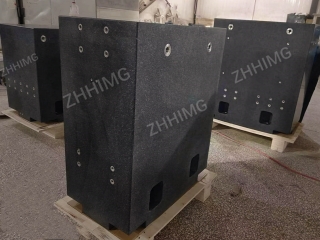The linear expansion coefficient of granite is usually around 5.5-7.5x10 - ⁶/℃. However, different types of granite, its expansion coefficient may be slightly different.
Granite has good temperature stability, mainly reflected in the following aspects:
Small thermal deformation: due to its low expansion coefficient, the thermal deformation of granite is relatively small when the temperature changes. This allows granite components to maintain a more stable size and shape in different temperature environments, which is conducive to ensuring the accuracy of precision equipment. For example, in high-precision measuring instruments, the use of granite as a base or workbench, even if the ambient temperature has a certain fluctuation, the thermal deformation can be controlled in a small range, so as to ensure the accuracy of the measurement results.
Good thermal shock resistance: Granite can withstand a certain degree of rapid temperature changes without obvious cracks or damage. This is because it has good thermal conductivity and heat capacity, which can transfer heat quickly and evenly when the temperature changes, reducing the internal thermal stress concentration. For example, in some industrial production environments, when the equipment suddenly starts or stops running, the temperature will change rapidly, and granite components can better adapt to this thermal shock and maintain the stability of their performance.
Good long-term stability: After a long period of natural aging and geological action, the internal stress of granite has been basically released, and the structure is stable. In the long-term use process, even after multiple temperature cycle changes, its internal structure is not easy to change, can continue to maintain good temperature stability, providing reliable support for high-precision equipment.
Compared with other common materials, the thermal stability of granite is at a higher level, the following is the comparison between granite and metal materials, ceramic materials, composite materials in terms of thermal stability:
Compared with metal materials:
The coefficient of thermal expansion of general metal materials is relatively large. For example, the linear expansion coefficient of ordinary carbon steel is about 10-12x10 - ⁶/℃, and the linear expansion coefficient of aluminum alloy is about 20-25x10 - ⁶/℃, which is significantly higher than granite. This means that when the temperature changes, the size of the metal material changes more significantly, and it is easy to produce greater internal stress due to thermal expansion and cold contraction, thus affecting its accuracy and stability. The size of granite changes less when the temperature fluctuates, which can better maintain the original shape and accuracy. The thermal conductivity of metal materials is usually high, and in the process of rapid heating or cooling, heat will be rapidly conducted, resulting in a large temperature difference between the inside and the surface of the material, resulting in thermal stress. In contrast, the thermal conductivity of granite is low, and the heat conduction is relatively slow, which can alleviate the generation of thermal stress to a certain extent and show better thermal stability.
Compared with ceramic materials:
The thermal expansion coefficient of some high-performance ceramic materials can be very low, such as silicon nitride ceramics, whose linear expansion coefficient is about 2.5-3.5x10 - ⁶/℃, which is lower than granite, and has certain advantages in thermal stability. However, ceramic materials are usually brittle, thermal shock resistance is relatively poor, and cracks or even cracks are easy to occur when the temperature changes sharply. Although the thermal expansion coefficient of granite is slightly higher than some special ceramics, it has good toughness and thermal shock resistance, can withstand a certain degree of temperature mutation, in practical applications, for most non-extreme temperature change environment, granite thermal stability can meet the requirements, and its comprehensive performance is more balanced, the cost is relatively low.
Compared with composite materials:
Some advanced composite materials can achieve low coefficient of thermal expansion and good thermal stability through reasonable design of the combination of fiber and matrix. For example, the coefficient of thermal expansion of carbon fiber reinforced composites can be adjusted according to the direction and content of the fiber, and can reach very low values in some directions. However, the preparation process of composite materials is complicated and the cost is high. As a natural material, granite does not need complex preparation process, and the cost is relatively low. Although it may not be as good as some high-end composite materials in some indicators of thermal stability, it has advantages in terms of cost performance, so it is widely used in many conventional applications that have certain requirements for thermal stability. In which industries are granite components used, temperature stability is a key consideration? Provide some specific test data or cases of granite thermal stability. What are the differences between different types of granite thermal stability?
Post time: Mar-28-2025

